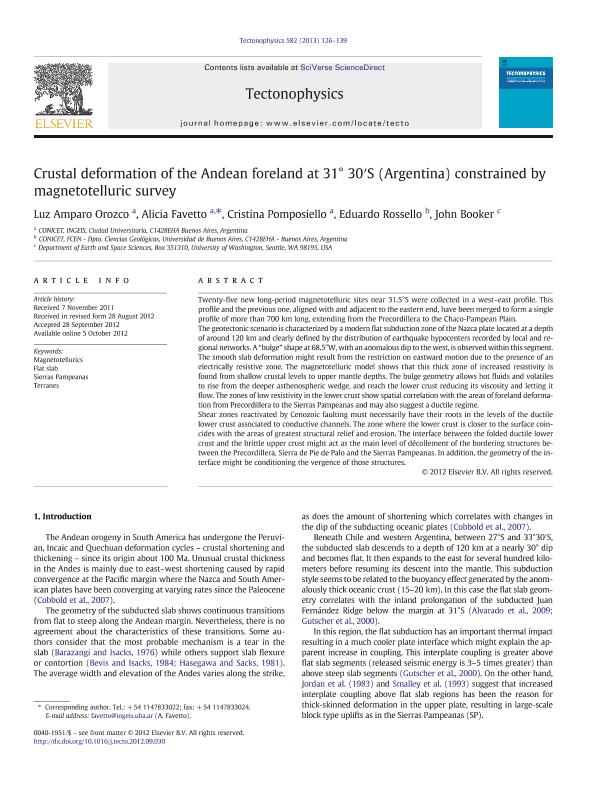Mostrar el registro sencillo del ítem
dc.contributor.author
Orozco, Luz Amparo
dc.contributor.author
Favetto, Alicia Beatriz

dc.contributor.author
Pomposiello, Maria Cristina

dc.contributor.author
Rossello, Eduardo Antonio

dc.contributor.author
Booker, John
dc.date.available
2017-05-02T18:09:18Z
dc.date.issued
2013-01
dc.identifier.citation
Orozco, Luz Amparo; Favetto, Alicia Beatriz; Pomposiello, Maria Cristina; Rossello, Eduardo Antonio; Booker, John; Crustal deformation of the Andean foreland at 31° 30′S (Argentina) constrained by magnetotelluric survey; Elsevier Science; Tectonophysics; 582; 1-2013; 126-139
dc.identifier.issn
0040-1951
dc.identifier.uri
http://hdl.handle.net/11336/15869
dc.description.abstract
Twenty-five new long-period magnetotelluric sites near 31.5°S were collected in a west–east profile. This profile and the previous one, aligned with and adjacent to the eastern end, have been merged to form a single profile of more than 700 km long, extending from the Precordillera to the Chaco-Pampean Plain. The geotectonic scenario is characterized by a modern flat subduction zone of the Nazca plate located at a depth of around 120 km and clearly defined by the distribution of earthquake hypocenters recorded by local and regional networks. A “bulge” shape at 68.5°W, with an anomalous dip to the west, is observed within this segment. The smooth slab deformation might result from the restriction on eastward motion due to the presence of an electrically resistive zone. The magnetotelluric model shows that this thick zone of increased resistivity is found from shallow crustal levels to upper mantle depths. The bulge geometry allows hot fluids and volatiles to rise from the deeper asthenospheric wedge, and reach the lower crust reducing its viscosity and letting it flow. The zones of low resistivity in the lower crust show spatial correlation with the areas of foreland deformation from Precordillera to the Sierras Pampeanas and may also suggest a ductile regime. Shear zones reactivated by Cenozoic faulting must necessarily have their roots in the levels of the ductile lower crust associated to conductive channels. The zone where the lower crust is closer to the surface coincides with the areas of greatest structural relief and erosion. The interface between the folded ductile lower crust and the brittle upper crust might act as the main level of décollement of the bordering structures between the Precordillera, Sierra de Pie de Palo and the Sierras Pampeanas. In addition, the geometry of the interface might be conditioning the vergence of those structures.
dc.format
application/pdf
dc.language.iso
eng
dc.publisher
Elsevier Science

dc.rights
info:eu-repo/semantics/openAccess
dc.rights.uri
https://creativecommons.org/licenses/by-nc-nd/2.5/ar/
dc.subject
Magnetotellurics
dc.subject
Flat Slab
dc.subject
Sierras Pampeanas
dc.subject
Terranes
dc.subject.classification
Geoquímica y Geofísica

dc.subject.classification
Ciencias de la Tierra y relacionadas con el Medio Ambiente

dc.subject.classification
CIENCIAS NATURALES Y EXACTAS

dc.title
Crustal deformation of the Andean foreland at 31° 30′S (Argentina) constrained by magnetotelluric survey
dc.type
info:eu-repo/semantics/article
dc.type
info:ar-repo/semantics/artículo
dc.type
info:eu-repo/semantics/publishedVersion
dc.date.updated
2017-04-28T20:29:43Z
dc.journal.volume
582
dc.journal.pagination
126-139
dc.journal.pais
Países Bajos

dc.journal.ciudad
Amsterdam
dc.description.fil
Fil: Orozco, Luz Amparo. Consejo Nacional de Investigaciones Científicas y Técnicas. Oficina de Coordinación Administrativa Ciudad Universitaria. Instituto de Geocronología y Geología Isotopica. Universidad de Buenos Aires. Facultad de Ciencias Exactas y Naturales. Instituto de Geocronología y Geología Isotopica; Argentina
dc.description.fil
Fil: Favetto, Alicia Beatriz. Consejo Nacional de Investigaciones Científicas y Técnicas. Oficina de Coordinación Administrativa Ciudad Universitaria. Instituto de Geocronología y Geología Isotopica. Universidad de Buenos Aires. Facultad de Ciencias Exactas y Naturales. Instituto de Geocronología y Geología Isotopica; Argentina
dc.description.fil
Fil: Pomposiello, Maria Cristina. Consejo Nacional de Investigaciones Científicas y Técnicas. Oficina de Coordinación Administrativa Ciudad Universitaria. Instituto de Geocronología y Geología Isotopica. Universidad de Buenos Aires. Facultad de Ciencias Exactas y Naturales. Instituto de Geocronología y Geología Isotopica; Argentina
dc.description.fil
Fil: Rossello, Eduardo Antonio. Universidad de Buenos Aires. Facultad de Ciencias Exactas y Naturales. Departamento de Ciencias Geológicas; Argentina. Consejo Nacional de Investigaciones Científicas y Técnicas; Argentina
dc.description.fil
Fil: Booker, John. University of Washington; Estados Unidos
dc.journal.title
Tectonophysics

dc.relation.alternativeid
info:eu-repo/semantics/altIdentifier/doi/http://dx.doi.org/10.1016/j.tecto.2012.09.030
dc.relation.alternativeid
info:eu-repo/semantics/altIdentifier/url/http://www.sciencedirect.com/science/article/pii/S0040195112006312
Archivos asociados
